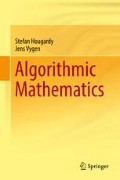Abstract
When solving numerical computational problems one always has to expect errors. Because there are only finitely many machine numbers, errors can occur not only when inputting data (the number 0.1, for example, has no exact binary representation with finitely many digits; cf. Example 4.2), but also when using the elementary operations +, −, ⋅ and ∕. Moreover, the desired answer may be a nonrepresentable number.
Access this chapter
Tax calculation will be finalised at checkout
Purchases are for personal use only
Author information
Authors and Affiliations
Rights and permissions
Copyright information
© 2016 Springer International Publishing Switzerland
About this chapter
Cite this chapter
Hougardy, S., Vygen, J. (2016). Computing with Errors. In: Algorithmic Mathematics. Springer, Cham. https://doi.org/10.1007/978-3-319-39558-6_5
Download citation
DOI: https://doi.org/10.1007/978-3-319-39558-6_5
Published:
Publisher Name: Springer, Cham
Print ISBN: 978-3-319-39557-9
Online ISBN: 978-3-319-39558-6
eBook Packages: Mathematics and StatisticsMathematics and Statistics (R0)

